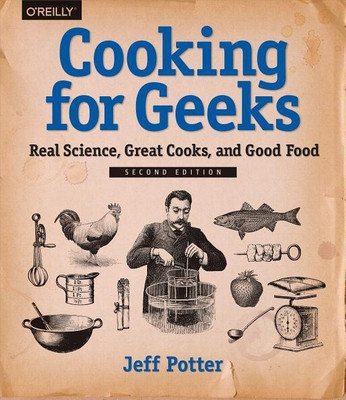Cooking for Geeks, 2e(English, Paperback, Potter Jeff)
Quick Overview
Product Price Comparison
Are you the innovative type, the cook who marches to a different drummer -- used to expressing your creativity instead of just following recipes? Are you interested in the science behind what happens to food while it's cooking? Do you want to learn what makes a recipe work so you can improvise and create your own unique dish? More than just a cookbook, Cooking for Geeks applies your curiosity to discovery, inspiration, and invention in the kitchen. Why is medium-rare steak so popular? Why do we bake some things at 350┬░ F/175┬░ C and others at 375┬░ F/190┬░ C? And how quickly does a pizza cook if we overclock an oven to 1,000┬░ F/540┬░ C? Author and cooking geek Jeff Potter provides the answers and offers a unique take on recipes -- from the sweet (a "mean" chocolate chip cookie) to the savory (duck confit sugo). This book is an excellent and intriguing resource for anyone who wants to experiment with cooking, even if you don't consider yourself a geek. Initialize your kitchen and calibrate your tools Learn about the important reactions in cooking, such as protein denaturation, Maillard reactions, and caramelization, and how they impact the foods we cook Play with your food using hydrocolloids and sous vide cooking Gain firsthand insights from interviews with researchers, food scientists, knife experts, chefs, writers, and more, including author Harold McGee, TV personality Adam Savage, chemist Hervé This, and xkcd Table of Contents Chapter 1 Hello, Kitchen! Think Like a Hacker Cooking for One Cooking for Others Chapter 2 Initializing the Kitchen Approaching the Kitchen Kitchen Equipment Kitchen Organization Chapter 3 Choosing Your Inputs: Flavors and Ingredients Smell + Taste = Flavor Tastes: Bitter, Salty, Sour, Sweet, Umami, Others Adapt and Experiment Method Regional/Traditional Method Seasonal Method Analytical Method Chapter 4 Time and Temperature: CookingŌĆÖs Primary Variables Cooked = Time * Temperature Foodborne Illness and Staying Safe bacteriadanger zone rulebacteriafoodborne illness andbacteriasurvival temperaturesdanger zone rulefood safetydanger zone rulefood safetyfoodborne illness andmarinating meatsmeatsmarinatingmeatstenderizingWell, saferŌĆöthereŌĆÖs no such thing as 100% safe. Key Temperatures in Cooking Chapter 5 Air: BakingŌĆÖs Key Variable Gluten Biological Leaveners Chemical Leaveners Mechanical Leaveners Chapter 6 Playing with Chemicals Traditional Cooking Chemicals Modern Industrial Chemicals Chapter 7 Fun with Hardware Sous Vide Cooking Commercial Hardware and Techniques Appendix Cooking Around Allergies Substitutions for Common Allergies Appendix Afterword Appendix About the Author Colophon ┬Ā


